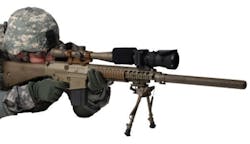DARPA seeks to design tiny radio transmitters with fundamental improvements to RF amplifier power supplies
This is a growing problem, because many of today's military radio systems, as well as those envisioned in the future, use complex modulation techniques with high peak-to-average ratios in signal amplitude. Although the systems are designed for fixed operation at peak condition, power amplifiers typically operate well below peak output power much of the time.
To improve the efficient use of power and diverse signal waveforms, DARPA scientists are looking for new envelope tracking or other drain bias modulation techniques to enable RF power supplies to operate far more efficiently by changing the DC voltage that it supplies to the power amplifier rapidly.
The Microscale Power Conversion program seeks to develop power electronics technology for efficient, very fast supply modulation with high power handling capabilities to make practical use of new RF power amplifier designs. The program seeks to develop a compact, power-efficient RF transmitter by inventing dynamic power conditioning circuits and closely integrating them with RF MMIC power amplifiers and necessary control circuits.
The electrical supply chain from the AC power source to power amplifier supply typically functions as three lumped stages, DARPA officials explain: converting AC power to high-voltage DC power; converting high-voltage DC power to an intermediate DC voltage; and, finally, conditioning the resulting power to remove ripple and make subtle adjustments. In the final stage, the drain bias is either on or off at a set value.
DARPA is focusing the MPC program on the final stage of this process by seeking to develop an efficient high-speed power supply modulator to convert input DC voltage rapidly to any DC supply voltage. For this the key enabling technology will be a fast, low-loss gallium nitride power switch.
DARPA scientists want to focus the MPC program first on designing high-speed, low-loss packaged field-effect transistor (FET) power switches, and then on the co-designing and prototyping the RF transmitter and supply modulator.
DARPA officials say they expect to award contracts to several teams in a two-to-three-year effort to establish the power switch foundry capability and to demonstrate the feasibility of high efficiency RF transmitters with microscale power conversion technology.
Companies interesting in submitting proposals to DARPA should send abstracts no later than 11 April 2011, and full proposals no later than 10 June 2011.
For questions or concerns contact DARPA's John Albrecht by e-mail at [email protected]. More information is online at https://www.fbo.gov/spg/ODA/DARPA/CMO/DARPA-BAA-11-33/listing.html.
